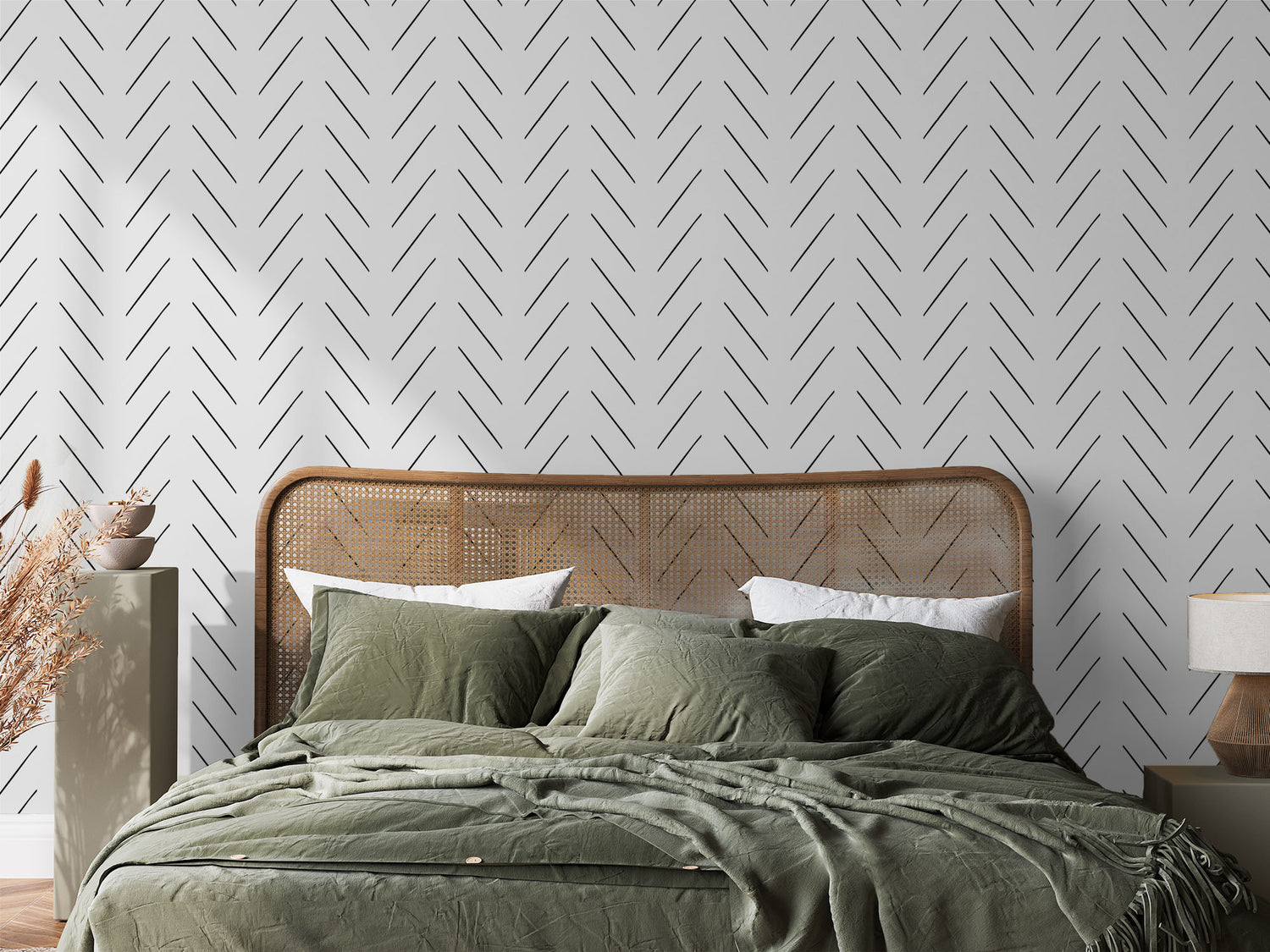Installation Instructions
Choose your paper type below for installation instructions.Peel & Stick Wallpaper
Instructions For Peel & Stick Wallpaper
Important Information
- Peel & Stick wallpaper will not work over stain-blocking or water-repellent paints, please prime the wall if you have one of these paints.
- Peel & Stick wallpaper will not work over wallpaper primers which are designed to enhance removability (such as Zinsser Shieldz Wallcovering Primer).
- Peel & Stick wallpaper will not work over over 2-in-1 Paint & Primer.
Preparation
- We recommend installing this material with 2 people, unless you are experienced and confident with our material.
- Please remember that the wallpaper material we use may be different to peel & stick materials you have used in the past.
- Ensure the wall is flat, clean and dry before application. Any dust may cause the adhesive to fail, so wipe down the wall with a damp cloth and leave to dry before installing.
- Freshly painted walls should be left for 4 weeks before application.
- Make sure the wall is even in color.
- If applying to a porous surface (plaster, cement render) ensure plaster is stable and free of mold.
- If applying over a stain-blocking or water-repellant paint, prime the wall first.
- Your wallpaper may need cutting between the panels along the black lines to separate the panels.
- Allow the unrolled wallpaper to acclimatise in the room it will be applied in for a minimum of 48 hours before application.
Step 1 - Draw A Vertical
Measure 18"/45cm (19"/48cm drop width, less 1"/3cm for trimming) from the left-hand side of your wall. Use a spirit level or plumb line to lightly draw a vertical line.
Tip: Use a laser level and you won't need to draw the line.
Step 2 - Peel Away (A Little) Backing Paper
Remove approximately 30cm/1ft of backing paper from the top of drop 2, ready to apply.
Step 3 - Install Panel 2
Starting with the top of the panel 1"/3cm higher than the top of your wall, line the left-hand edge of the drop to the vertical line you drew in step 1. This should leave a space on the left-hand side of the wall for panel 1.
Let the paper hang naturally. If it is not straight, then peel off and reposition the top until it hangs straight. Smooth down the paper with the included felt tool, working down. Keep peeling off the backing paper a little at a time as you go down the wall.
Tip: The straighter this panel is applied, the straighter the rest of the wallpaper is, so make sure it aligns well to the vertical line.
Step 4 - Install Panel 1
Peel away a little backing paper at the top as before, and line up the right-hand edge of panel 1 to butt-join against the left-hand edge of panel 2 at the top. Stick down the joining edge first, ensuring the paper will hang naturally against panel 2. Smooth away from the join.
You may need to cut diagonally into the corner to allow the paper to fold at the edges. Make sure you still have around 1"/3cm excess material at the top, left, and bottom.
Step 5 - Install Remaining Panels
Continue with panel 3 and the remaining panels. Visually match the design to the previous drop and
join edge to edge (no overlap). Firmly butt the panels at
the top, stick the join down, and let the paper hang naturally. Smooth downwards and away from the join.
Step 6 - Trim Edges
Use a utility or craft knife to trim the edges of the paper against the wall, ceiling, skirting board, or other obstacles.
Use the included felt tool to push the wallpaper against the wall whilst you cut to ensure it doesn't drag.
Paste-The-Wall Wallpaper
Instructions For Paste-The-Wall Wallpaper
Important Information
• Paste the wall, not the paper.
• Use pre-mixed ‘paste-the-wall’ paste or 'non-woven' paste if available. Avoid powdered paste as it can cause shrinkage.
Preparation
- Freshly painted walls should be left for 4 weeks before application.
- Ensure the wall is flat, clean, smooth and dry before application.
- Make sure the wall is even in colour.
- Bumps and rough patches on the wall should be sanded smooth with 1200 grit sandpaper.
- Remove any old backing paper from wall surface.
- If applying to a porous surface (plaster, cement render) ensure plaster is stable and free of mould.
- Your wallpaper may need cutting between the panels along the black lines to separate the panels.
- Allow the unrolled wallpaper to acclimatise in the room it will be applied in for a minimum of 48 hours before application.
Step 1 - Draw A Vertical
Measure 18"/45cm (19"/48cm drop width, less 1"/3cm for trimming) from the left-hand side of your wall. Use a spirit level or plumb line to lightly draw a vertical line.
Tip: Use a laser level and you won't need to draw the line.
Step 2 - Paste The Wall
Apply a very thin layer of pre-mixed paste to the wall with a brush or roller. Be careful not to use too much paste, as this can soak the paper and cause shrinkage.
Step 3 - Install Panel 2
Starting with the top of the drop 1"/3cm higher than the top of your wall for trimming, line the left-hand edge of the drop to the vertical line you drew in step 1. This should leave a space on the left-hand side of the wall for panel 1.
Tip: The straighter this drop is applied, the straighter the rest of the mural is, so make sure it aligns well to the vertical line.
Step 4 - Install Panel 1
Line up the right-hand edge of panel 1 to butt-join against the left-hand edge of panel 2. Make sure you still have around 1"/3cm excess material at the top and left for trimming. You may need to cut diagonally into the corner to allow the paper to fold at the edges.
Step 5 - Install Remaining Panels
Continue with panel 3 and the remaining panels. Visually match the design to the previous drop and
join edge to edge (no overlap). Firmly butt the panels at
the top and let the paper hang naturally. Brush downwards, making sure the join is tightly
butted all the way down. You can use a seam roller to ensure the product has bonded well at the joins and gently wipe away any excess paste.
Step 6 - Trim Edges
Use a utility or craft knife to trim the edges of the paper against the wall, ceiling, skirting board, or other obstacles.
Tip: Use a straight edge to hold the paper down whilst you cut to prevent dragging.
Step 7 - Leave To Dry
Leave your finished wallpaper for the paste to dry. It is very important that in the 12-24 hours after installation, there are no changes in temperature or humidity, so heating/cooling systems should be turned off.
Peel & Stick Vinyl
Instructions For Peel & Stick Vinyl
Important Information
- Peel & Stick wallpaper will not work over stain-blocking or water-repellent paints, please prime the wall if you have one of these paints.
- Please avoid wallpaper primers which are designed to enhance removability (such as Zinsser Shieldz Wallcovering Primer).
- Peel & Stick wallpaper will not work over over 2-in-1 Paint & Primer.
Preparation
- Ensure the wall is flat, clean and dry before application. Any dust may cause the adhesive to fail, so wipe down the wall with a damp cloth and leave to dry before installing.
- We recommend installing this material with 2 people, unless you are experienced and confident with our material.
- Please remember that the wallpaper material we use may be different to peel & stick materials you have used in the past.
- Freshly painted walls should be left for 4 weeks before application.
- Make sure the wall is even in color.
- If applying to a porous surface (plaster, cement render) ensure plaster is stable and free of mold.
- If applying over a stain-blocking or water-repellant paint, prime the wall first.
- Your wallpaper may need cutting between the panels along the black lines to separate the panels.
- Allow the unrolled wallpaper to acclimatise in the room it will be applied in for a minimum of 48 hours before application.
Step 1 - Draw A Vertical
Measure 24"/62cm (25"/65cm drop width, less 1"/3cm for trimming) from the left-hand side of your wall. Use a spirit level or plumb line to lightly draw a vertical line.
Tip: Use a laser level and you won't need to draw the line.
Step 2 - Peel Away (A Little) Backing Paper
Remove approximately 30cm/1ft of backing paper from the top of panel 1, ready to apply.
Step 3 - Install Panel 1
Starting with the top of the panel 1"/3cm higher than the top of your wall, line the right-hand edge of the drop to the vertical line you drew in step 1.
Let the vinyl hang naturally. If it is not straight, then peel off and reposition the top until it hangs straight. Stick the vinyl on the right hand edge first until it is hanging straight, then smooth down the vinyl with the included felt tool, working down and to the left. Keep peeling off the backing paper a little at a time as you go down the wall.
You may need to cut diagonally into the corner to allow the vinyl to fold at the edges. Be careful not to stretch the material as this will cause bubbles and misalignment.
Tip: The straighter this panel is applied, the straighter the rest of the wallpaper is, so make sure it aligns well to the vertical line.
Step 4 - Install Panel 2
Overlap the left-hand edge of panel 2 onto the right-hand edge of panel 1 by around 1/4"/6mm until the pattern matches. Make sure you still have around 1"/3cm excess material at the top for trimming.
Step 5 - Install Remaining Panels
Continue with panel 3 and the remaining panels. Visually match the design to the previous drop and
overlap by 1/4"/6mm. Match the pattern and let the vinyl hang naturally. Match the join, then smooth downwards and away from the join, peeling off the liner as you go.
Step 6 - Trim Edges
Use a utility or craft knife to trim the edges of the paper against the wall, ceiling, skirting board, or other obstacles.
Use the included felt tool to push the wallpaper against the wall whilst you cut to ensure it doesn't drag.

